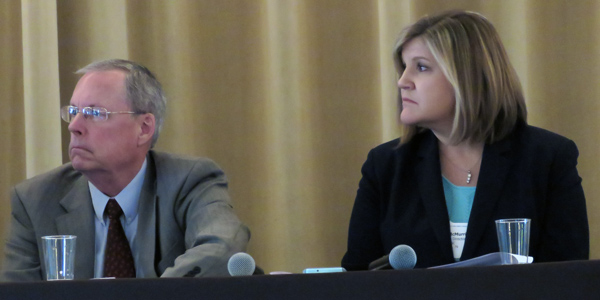CARROLL, N.H. — More than 300 regulators, market participants, consultants and RTO officials traveled to rainy Mount Washington last week for the 70th Annual Symposium of the New England Conference of Public Utilities Commissioners (NECPUC). Here’s some of what we heard.
NH Gov. Seeks Lower Power Prices

New Hampshire’s electric rates, among the highest in the country, are a big concern for Gov. Chris Sununu, he told a lunchtime audience on June 5.
The high cost of electricity “affects business, it affects families, it affects those on fixed income,” said Sununu, a former environmental engineer who took office in January. “New Hampshire has an aging population, with the median age older [than] Florida, believe it or not. … It tells me more folks are going to be on fixed incomes. We already have a pretty high property tax here. … That means when you talk about flexibility in discretionary income, it’s pretty minimal for some folks. So when we talk about utility costs and energy costs and where we’re going … it’s our job to provide them with as much flexibility as possible.”
At an average of more than 16 cents/kWh, New Hampshire ranked sixth in retail electric rates in 2015, according to the Energy Information Administration’s most recent available data. Only remote Hawaii and Alaska — and New England neighbors Connecticut, Rhode Island and Massachusetts — were more expensive.
Sununu blasted the state’s energy plan, calling it “terrible” and “very poorly written.” He also defended his decision not to join California, New York and other states in pledging to abide by the Paris Agreement on climate change.
“I found it humorous that the governors of California and New York — two of the worst environmental polluters in the country — thought that everyone should sign a piece of paper to reaffirm their environmental commitments,” he said, recalling his time living in smoggy California and cleaning up hazardous waste sites in New York. “We are one of the best in the country in terms of our environmental stewardship.”
Officials Hope for Progress on Nuclear Waste
Spent fuel rods and other radioactive waste from four decommissioned nuclear plants in New England sit on-site today, in some cases more than two decades after the plants were shuttered.
That provided the context for a panel on the status of commercial nuclear waste disposal titled “The Slow and the Furious,” the former referring to the federal government, the latter to unhappy utilities and state officials.
American electricity users paid more than $20 billion into the Nuclear Waste Fund between 1982 and 2014, a figure that has more than doubled as interest has accrued. About $11 billion of the $46 billion in the fund has been spent on the program so far, said Katrina McMurrian, executive director of the Nuclear Waste Strategy Coalition, an organization of state and utility officials formed in 1993 to push for a final resting place for radioactive waste.
McMurrian and other speakers saw reasons for optimism.
Plans for a permanent waste repository at Yucca Mountain in Nevada were squelched in 2009 when President Barack Obama ordered the Nuclear Regulatory Commission to stop work on a licensing permit, a move taken at the behest of then-Sen. Harry Reid (D-Nev.). The license application for the site, 140 miles northwest of Las Vegas, was the product of 30 years of work and billions in spending. Obama’s decision outraged nuclear operators and state regulators.
With Reid retired and a new president in office, two major political obstacles to Yucca are gone. President Trump’s proposed 2018 budget seeks funds for both the permanent repository at Yucca and “consolidated interim storage,” McMurrian said.
She outlined several bills have been introduced or are under discussion in Congress.
A comprehensive Senate bill, which was introduced in two prior Congresses, hasn’t been introduced again yet this session, but a comprehensive House “discussion draft” is expected to be filed soon, she said.
Neither specifically identify permanent disposal facilities. The House draft, the Nuclear Waste Policy Amendments Act of 2017, builds on existing NWPA direction to move ahead with Yucca. The Senate bill proposed seeking locations to volunteer for both permanent disposal and interim storage.
Rep. Darrell Issa (R-Calif.) has introduced a narrower bill on private interim storage, the Interim Consolidated Storage Act (H.R. 474).
NRC Chairwoman Kristine Svinicki has asked Congress for $30 million to review a revived license application for Yucca Mountain. At a congressional hearing Wednesday, she said it could take three to five years to resolve more than 300 legal challenges to Yucca Mountain, many of which were filed by the state over alleged risks to groundwater.
Svinicki also said it would take three years to complete licensing on sites in Texas and New Mexico, where private contractors are seeking to temporarily store waste.
One of those companies is Holtec International, whose program director, Ed Mayer, briefed NECPUC on the company’s New Mexico project, a 1,000-acre site he said was capable of storing all the waste from all the commercial reactors in the U.S.
Spent fuel rods must be cooled in 40-foot-deep water tanks for at least five years before being put into dry casks, where they need to be air-cooled by natural ventilation for at least another five years before being buried deep underground.
Robert Capstick, director of regulatory affairs for Yankee Atomic Electric Co., Maine Yankee and Connecticut Yankee, presented slides showing the challenge of moving nuclear waste. Dry transportation casks weigh about 100 tons, but Capstick noted that the decommissioning of the Yankee plants has already resulted in the transportation of radioactive reactor pressure vessels weighing between 300 and 1,000 tons.
“While the removal of the reactor pressure vessels from the Yankee sites was certainly a challenge, the slides showed that the transportation of large radioactive components during plant decommissioning was safely completed – and those packages far exceeded the size and weight of the future spent fuel transportation casks,” Capstick explained afterward.
— Michael Kuser






